Habitat Quality Evolution and Multi-Scenario Simulation Based on Land Use Change in the Jialing River Basin
Abstract
1. Introduction
2. Overview of the Study Area
3. Materials and Methods
- the examination of the study area’s spatiotemporal variations in land use between the year 2000 and the year 2020 and calculating the land use intensity index for 94 counties;
- the examination of the composition and geographic shifts in habitat quality between 2000 and 2020, taking notice of the distribution of habitat quality across various grades;
- the examination of LUCC’s effects on habitat quality during the years 2000 and 2020;
- the study and modeling of prospective habitat quality under four scenarios.
3.1. Analysis of Spatiotemporal Patterns of LUCC
3.1.1. Matrix of Land Use Transfer
3.1.2. Land Use Intensity Index
3.2. PLUS Model and Multiple Scenario Setting
3.2.1. PLUS Model
3.2.2. Model Evaluation
3.2.3. Future Scenario Setting
- The Business-as-usual Scenario (BAUS): This land use prediction for 2030 is based on changes in land use from 2010 to 2020, assuming that land use categories in the study region would vary from 2020 to 2030 according to historical trends and that there will not be any legislative restrictions on land use in 2030.
- The Farmland Conservation Scenario (FCS): Farmland protection is essential for food security since the studied region is a national agricultural producing region. Since it is forbidden to convert farmland to other land uses under the Farmland Conservation Scenario, there is a 20% increase in the likelihood of converting other land uses to farmland.
- The Ecological Conservation Scenario (ECS): The goal of ecological conservation is to coordinate land usage and ecological building in order to create a civilization that is favorable to the environment. In this scenario, converting forestland to other land types is prohibited, and the likelihood of water area and farmland being converted to construction or unused land is cut by 50%. Meanwhile, the probability of other land types being converted to forestland increases by 50%, while conversions to grassland and water area are elevated by 30%.
- The Sustainable Development Scenario (SDS): In response to the Chinese government’s initiatives to create a low-carbon, green economy, the preservation of the natural environment is given top priority throughout urban expansion, guaranteeing the long-term growth of the economy and society. There is a thirty percent rise in the likelihood of farmland being converted to forestland and grassland under the sustainable development scenario. There is an 80% decrease in the likelihood of converting forestland and grassland to farmland, and a 50% decrease in the likelihood of converting construction land to farmland. There is a 50% increased chance that unused land will be converted to construction land.
3.3. InVEST Model and Habitat Quality Module
3.4. The Effect of LUCC on the Quality of Habitat
3.5. Bivariate Examination of Spatial Autocorrelation
4. Results
4.1. LUCC in the Jialing River Basin
4.1.1. Spatial-Temporal Characteristics of LUCC between 2000 and 2020
4.1.2. Land Use Transfer Analysis
4.2. Patterns of Temporal and Spatial Evolution in Habitat Quality
4.3. Changes in Land Use’s Effects on Habitat Quality
4.3.1. Land Use Transfer’s Effect on Habitat Quality
4.3.2. The Association between Habitat Quality and Land Use Intensity
4.4. Multi-Scenario Modeling and Habitat Quality Analysis
5. Discussion
5.1. LUCC’s Effects on the Quality of the Habitat
5.2. Challenges and Strategies for Future Habitats
5.3. Study Limitations and Potential for the Future
6. Conclusions
- In the study area, the southern hilly regions are primarily covered with farmland, while the northern mountainous regions are predominantly forested. Together, these two land types constitute over 90% of the area’s total land cover. Over the past 20 years, the most significant changes in land type proportions include a decrease of 1.46% in grassland and an increase of 1.07% in construction land. The expansion of construction land was particularly pronounced in the latter 10 years compared to the earlier decade.
- The research area’s habitat quality value range for the years 2000, 2010, and 2020 was 0 to 0.9, with corresponding average values of 0.5401, 0.5338, and 0.5084. This indicates that overall habitat quality is typically modest with a danger of additional decline, even while small regions show a high habitat structure and landscape stability.
- The habitat quality of the study region is directly correlated with the percentage of each land use type, and most land use changes have a negligible effect on it. The main factor contributing to the deterioration of habitat quality is farmland’s encroachment into grasslands and forests.
- With a tendency towards declining spatial heterogeneity, the worldwide Moran’s I indices for the years 2000, 2010, and 2022 were −0.7809, −0.7537, and −0.6376, respectively, showing a substantial negative association between land use intensity and habitat quality in the studied region. The research region mostly displays the following two modes, according to the LISA maps: high land use intensity related to poor habitat quality (high–low) and low land use intensity relating to low habitat quality (low–low).
- The results of the habitat simulations under the four future scenarios show that, with the exception of the ecological protection scenario, where habitat quality improves, there is a specific level of degradation in the habitat quality under the business-as-usual, farmland conservation, and sustainable development scenario. Active ecological protection measures have a significant effect on improving habitat quality, providing a clear direction for ecological environment management in the study area.
Author Contributions
Funding
Institutional Review Board Statement
Informed Consent Statement
Data Availability Statement
Conflicts of Interest
References
- Bunce, R.G.H.; Bogers, M.M.B.; Evans, D.; Halada, L.; Mucher, S.; Bauch, B.; De Blust, G.; Parr, T.W.; Olsvig-Whittaker, L. The significance of habitats as indicators of biodiversity and their links to species. Ecol. Indic. 2012, 33, 19–25. [Google Scholar] [CrossRef]
- Petren, K. Habitat and Niche, Concept of. In Encyclopedia of Biodiversity, 2nd, ed.; Levin, S.A., Ed.; Academic Press: Waltham, MA, USA, 2001; pp. 39–49. [Google Scholar]
- Doi, H.; Katano, I.; Negishi, J.N.; Sanada, S.; Kayaba, Y. Effects of biodiversity, habitat structure, and water quality on recreational use of rivers. Ecosphere 2013, 4, art102. [Google Scholar] [CrossRef]
- Cardinale, B.J.; Duffy, J.E.; Gonzalez, A.; Hooper, D.U.; Perrings, C.; Venail, P.; Narwani, A.; Mace, G.M.; Tilman, D.; Wardle, D.A.; et al. Biodiversity loss and its impact on humanity. Nature 2012, 486, 59–67. [Google Scholar] [CrossRef] [PubMed]
- Fahrig, L. Effects of Habitat Fragmentation on Biodiversity. Annu. Rev. Ecol. Evol. Syst. 2003, 34, 487–515. [Google Scholar] [CrossRef]
- Marselle, M.R.; Lindley, S.J.; Cook, P.A.; Bonn, A. Biodiversity and Health in the Urban Environment. Curr. Environ. Health Rep. 2021, 8, 146–156. [Google Scholar] [CrossRef]
- Heinz, A.; Deserno, L.; Reininghaus, U. Urbanicity, social adversity and psychosis. World Psychiatry Off. J. World Psychiatr. Assoc. (WPA) 2013, 12, 187–197. [Google Scholar] [CrossRef]
- McDonald, R.I.; Mansur, A.V.; Ascensão, F.; Colbert, M.L.; Crossman, K.; Elmqvist, T.; Gonzalez, A.; Güneralp, B.; Haase, D.; Hamann, M.; et al. Research gaps in knowledge of the impact of urban growth on biodiversity. Nat. Sustain. 2020, 3, 16–24. [Google Scholar] [CrossRef]
- Liu, D.; Liang, X.; Chen, H.; Zhang, H.; Mao, N. A Quantitative Assessment of Comprehensive Ecological Risk for a Loess Erosion Gully: A Case Study of Dujiashi Gully, Northern Shaanxi Province, China. Sustainability 2018, 10, 3239. [Google Scholar] [CrossRef]
- Gao, Y.; Ma, L.; Liu, J.; Zhuang, Z.; Huang, Q.; Li, M. Constructing Ecological Networks Based on Habitat Quality Assessment: A Case Study of Changzhou, China. Sci. Rep. 2017, 7, 46073. [Google Scholar] [CrossRef]
- Nelson, E.; Mendoza, G.; Regetz, J.; Polasky, S.; Tallis, H.; Cameron, D.; Chan, K.M.A.; Daily, G.C.; Goldstein, J.; Kareiva, P.M.; et al. Modeling multiple ecosystem services, biodiversity conservation, commodity production, and tradeoffs at landscape scales. Front. Ecol. Environ. 2009, 7, 4–11. [Google Scholar] [CrossRef]
- Polasky, S.; Nelson, E.; Pennington, D.; Johnson, K.A. The Impact of Land-Use Change on Ecosystem Services, Biodiversity and Returns to Landowners: A Case Study in the State of Minnesota. Environ. Resour. Econ. 2011, 48, 219–242. [Google Scholar] [CrossRef]
- McKinney, M. Urbanization, Biodiversity, and Conservation. BioScience 2002, 52, 883–890. [Google Scholar] [CrossRef]
- McDonald, R.I.; Kareiva, P.; Forman, R.T.T. The implications of current and future urbanization for global protected areas and biodiversity conservation. Biol. Conserv. 2008, 141, 1695–1703. [Google Scholar] [CrossRef]
- Kowarik, I. Novel urban ecosystems, biodiversity, and conservation. Environ. Pollut. 2011, 159, 1974–1983. [Google Scholar] [CrossRef] [PubMed]
- Güneralp, B.; Lwasa, S.; Masundire, H.; Parnell, S.; Seto, K.C. Urbanization in Africa: Challenges and opportunities for conservation. Environ. Res. Lett. 2017, 13, 015002. [Google Scholar] [CrossRef]
- Haddad, N.M.; Brudvig, L.A.; Clobert, J.; Davies, K.F.; Gonzalez, A.; Holt, R.D.; Lovejoy, T.E.; Sexton, J.O.; Austin, M.P.; Collins, C.D.; et al. Habitat fragmentation and its lasting impact on Earth’s ecosystems. Sci. Adv. 2015, 1, e1500052. [Google Scholar] [CrossRef]
- Li, X.; Yeh, A.G.-O. Analyzing spatial restructuring of land use patterns in a fast growing region using remote sensing and GIS. Landsc. Urban Plan. 2004, 69, 335–354. [Google Scholar] [CrossRef]
- Seto, K.C.; Fragkias, M.; Güneralp, B.; Reilly, M.K. A Meta-Analysis of Global Urban Land Expansion. PLoS ONE 2011, 6, e23777. [Google Scholar] [CrossRef]
- Ramankutty, N.; Foley, J.A. Estimating historical changes in global land cover: Croplands from 1700 to 1992. Glob. Biogeochem. Cycles 1999, 13, 997–1027. [Google Scholar] [CrossRef]
- Foley, J.A.; DeFries, R.; Asner, G.P.; Barford, C.; Bonan, G.; Carpenter, S.R.; Chapin, F.S.; Coe, M.T.; Daily, G.C.; Gibbs, H.K.; et al. Global Consequences of Land Use. Science 2005, 309, 570–574. [Google Scholar] [CrossRef]
- Song, Y.; Wang, M.; Sun, X.; Fan, Z. Quantitative assessment of the habitat quality dynamics in Yellow River Basin, China. Environ. Monit. Assess. 2021, 193, 614. [Google Scholar] [CrossRef]
- Zheng, H.; Li, H. Spatial–temporal evolution characteristics of land use and habitat quality in Shandong Province, China. Sci. Rep. 2022, 12, 15422. [Google Scholar] [CrossRef]
- Li, Q.; Zhou, Y.; Mary, A.C.; Xu, T. Spatio-temporal Changes in Wildlife Habitat Quality in the Middle and Lower Reaches of the Yangtze River from 1980 to 2100 based on the InVEST Model. J. Resour. Ecol. 2021, 12, 43–55. [Google Scholar]
- Arunyawat, S.; Shrestha, R.P. Assessing Land Use Change and Its Impact on Ecosystem Services in Northern Thailand. Sustainability 2016, 8, 768. [Google Scholar] [CrossRef]
- Lee, D.-j.; Jeon, S.W. Estimating Changes in Habitat Quality through Land-Use Predictions: Case Study of Roe Deer (Capreolus pygargus tianschanicus) in Jeju Island. Sustainability 2020, 12, 10123. [Google Scholar] [CrossRef]
- Berta Aneseyee, A.; Noszczyk, T.; Soromessa, T.; Elias, E. The InVEST Habitat Quality Model Associated with Land Use/Cover Changes: A Qualitative Case Study of the Winike Watershed in the Omo-Gibe Basin, Southwest Ethiopia. Remote Sens. 2020, 12, 1103. [Google Scholar] [CrossRef]
- Admasu, S.; Yeshitela, K.; Argaw, M. Assessing habitat quality using the InVEST model in the Dire and Legedadi watersheds, central highland of Ethiopia: Implication for watershed management. Sustain. Environ. 2023, 9, 2242137. [Google Scholar] [CrossRef]
- Zhang, S.; Liu, Y.; Wang, T. How land use change contributes to reducing soil erosion in the Jialing River Basin, China. Agric. Water Manag. 2014, 133, 65–73. [Google Scholar] [CrossRef]
- Wang, Y.; Gong, J.; Zhu, Y. Integrating social-ecological system into watershed ecosystem services management: A case study of the Jialing River Basin, China. Ecol. Indic. 2024, 160, 111781. [Google Scholar] [CrossRef]
- Luo, L.; Li, X.; Liu, X.; Li, Q.; Mao, Z.; Ma, B. Spatial and Temporal Evolution of Habitat Quality in the West Qinling Mountains Based on Land Use Change from 1990 to 2020. Chin. Agric. Sci. Bull. 2024, 40, 101–111. [Google Scholar]
- Ma, S.; Shi, C.; Yang, G.; Xu, X.; Yin, J. Analysison Spatiotem poralChange ofLand UseBased on GIS Technology——Taking Xinjiang Tarim Basin as an Example. Res. Soil Water Conserv. 2013, 20, 177–181. [Google Scholar]
- Liang, X.; Guan, Q.; Clarke, K.C.; Liu, S.; Wang, B.; Yao, Y. Understanding the drivers of sustainable land expansion using a patch-generating land use simulation (PLUS) model: A case study in Wuhan, China. Comput. Environ. Urban Syst. 2021, 85, 101569. [Google Scholar] [CrossRef]
- Jiang, X.; Duan, H.; Liao, J.; Song, X.; Xue, X. Land use in the Gan-Lin-Gao region of middle reaches of Heihe River Basin based on a PLUS-SD coupling model. Arid. Zone Res. 2022, 39, 1246–1258. [Google Scholar]
- Lin, Z.; Peng, S. Comparison of multimodel simulations of land use and land cover change considering integrated constraints-A case study of the Fuxian Lake basin. Ecol. Indic. 2022, 142, 109254. [Google Scholar] [CrossRef]
- Cohen, J. A Coefficient of Agreement for Nominal Scales. Educ. Psychol. Meas. 1960, 20, 37–46. [Google Scholar] [CrossRef]
- Liu, J.; Liu, B.; Wu, L.; Miao, H.; Liu, J.; Jiang, K.; Ding, H.; Gao, W.; Liu, T. Prediction of land use for the next 30 years using the PLUS model’s multi-scenario simulation in Guizhou Province, China. Sci. Rep. 2024, 14, 13143. [Google Scholar] [CrossRef] [PubMed]
- Su, J.; Tang, B.; Liu, Y.; Jiang, W. Multi-scenario land use change simulation and ecosystem service function evaluation in Bazhong City based on FLUS model. Environ. Ecol. 2023, 5, 17–25. [Google Scholar]
- Sharp, R.; Douglass, J.; Wolny, S.; Arkema, K.; Bernhardt, J.; Bierbower, W.; Chaumont, N.; Denu, D.; Fisher, D.; Glowinski, K. InVEST 3.8. 7. User’s Guide. In The Natural Capital Project; Stanford University: Stanford, CA, USA, 2020. [Google Scholar]
- Liang, T.; Huang, Q.; Yang, F.; Mao, Y.; Luo, Y.; Wen, C.; Ren, X. Evolution and Prediction of Habitat Quality in the Three GorgesReservoir (Chongqing section) Based on the InVEST-PLUS Model. Resour. Environ. Yangtze Basin 2023, 32, 2184–2195. [Google Scholar]
- Li, X.; Fang, C.; Huang, J.; Mao, H. The urban land use transformations and associated effects on eco-environment in northwest china arid region:a case study in hexi region, gansu province. Quat. Sci. 2003, 23, 280–290. [Google Scholar]
- Zhang, S.; Jiang, H.; Wang, L.; Chen, G.; Yu, H. Analysis of Land Use Change and Ecological Effect in Shenyang from 2000 to 2020. Radio Eng. 2022, 52, 2222–2228. [Google Scholar]
- Haining, R.P. Spatial Autocorrelation. In International Encyclopedia of the Social & Behavioral Sciences; Smelser, N.J., Baltes, P.B., Eds.; Pergamon: Oxford, UK, 2001; pp. 14763–14768. [Google Scholar]
- Griffith, D.A. Understanding Spatial Autocorrelation: An Everyday Metaphor and Additional New Interpretations. Geographies 2023, 3, 543–562. [Google Scholar] [CrossRef]
- Gangodagamage, C.; Zhou, X.; Lin, H. Autocorrelation, Spatial. In Encyclopedia of GIS; Shekhar, S., Xiong, H., Eds.; Springer: Boston, MA, USA, 2008; pp. 32–37. [Google Scholar]
- Moran, P.A.P. Notes on Continuous Stochastic Phenomena. Biometrika 1950, 37, 17–23. [Google Scholar] [CrossRef] [PubMed]
- Anselin, L. Local Indicators of Spatial Association—LISA. Geogr. Anal. 1995, 27, 93–115. [Google Scholar] [CrossRef]
- Lu, Y.; Li, H. Temporal and Spatial Dynamic Evolution of Habitat QualityBased on Land Use Change from 2000 to 2020: Taking Wuhan Metropolitan Region as an Example. Res. Soil Water Conserv. 2022, 29, 391–398. [Google Scholar]
- Zhou, J.; Luo, J. Spatial-Temporal Differentiation Characteristics and Correlation ofEcosystem Service Value and Ecological Risk of Jialing River Basin. J. Chongqing Norm. Univ. (Nat. Sci.) 2023, 40, 73–83. [Google Scholar]
- Du, H.; Qu, B. Optimization of Landscape Pattern Based on Landscape Ecological Risk Assessment: Taking Jialing River Basin as an Example. J. Mianyang Teach. Coll. (Sci.) 2024, 43, 9–15. [Google Scholar]
- Yang, Z.; Ji, M.; Wang, P.; Song, R. Spatio-temporal Evolution Study of Habitat Quality in Sichuan Basin Based on InVEST Model. Geomat. Spat. Inf. Technol. 2023, 46, 64–71. [Google Scholar]
- Zhao, X.; Wang, Y.; He, X.; Liu, X.; Zhang, J.; Deng, Y.; Feng, Y.; Chu, L.; Zhang, Z. Changing features of habitat quality in Wuxi based on InVEST model. J. Nanjing For. Univ. (Nat. Sci. Ed.) 2024, 1, 1–10. [Google Scholar]
- Liu, H.; Lin, M.; Zhou, R.; Zhong, L. Spatial and temporal evolution of habitat quality in Guangdong-Hong Kong-Macao Greater Bay Area based on InVEST model. Ecol. Sci. 2021, 40, 82–91. [Google Scholar]
- Fitzherbert, E.B.; Struebig, M.J.; Morel, A.; Danielsen, F.; Brühl, C.A.; Donald, P.F.; Phalan, B. How will oil palm expansion affect biodiversity? Trends Ecol. Evol. 2008, 23, 538–545. [Google Scholar] [CrossRef]
- Yu, Q.; Hu, Q.; van Vliet, J.; Verburg, P.H.; Wu, W. GlobeLand30 shows little cropland area loss but greater fragmentation in China. Int. J. Appl. Earth Obs. Geoinf. 2018, 66, 37–45. [Google Scholar] [CrossRef]
- Postek, P.; Leń, P.; Stręk, Ż. The proposed indicator of fragmentation of agricultural land. Ecol. Indic. 2019, 103, 581–588. [Google Scholar] [CrossRef]
- Tilman, D.; Fargione, J.; Wolff, B.; D’Antonio, C.; Dobson, A.; Howarth, R.; Schindler, D.; Schlesinger, W.H.; Simberloff, D.; Swackhamer, D. Forecasting Agriculturally Driven Global Environmental Change. Science 2001, 292, 281–284. [Google Scholar] [CrossRef] [PubMed]
- Tilman, D. Global environmental impacts of agricultural expansion: The need for sustainable and efficient practices. Proc. Natl. Acad. Sci. USA 1999, 96, 5995–6000. [Google Scholar] [CrossRef]
- West, P.C.; Gibbs, H.K.; Monfreda, C.; Wagner, J.; Barford, C.C.; Carpenter, S.R.; Foley, J.A. Trading carbon for food: Global comparison of carbon stocks vs. crop yields on agricultural land. Proc. Natl. Acad. Sci. USA 2010, 107, 19645–19648. [Google Scholar] [CrossRef]
- Johnson, J.A.; Runge, C.F.; Senauer, B.; Foley, J.; Polasky, S. Global agriculture and carbon trade-offs. Proc. Natl. Acad. Sci. USA 2014, 111, 12342–12347. [Google Scholar] [CrossRef]
- Lark, T.J.; Meghan Salmon, J.; Gibbs, H.K. Cropland expansion outpaces agricultural and biofuel policies in the United States. Environ. Res. Lett. 2015, 10, 044003. [Google Scholar] [CrossRef]
- Ma, S.; Wang, L.-J.; Jiang, J.; Zhao, Y.-G. Direct and indirect effects of agricultural expansion and landscape fragmentation processes on natural habitats. Agric. Ecosyst. Environ. 2023, 353, 108555. [Google Scholar] [CrossRef]
- Liu, J.; Coomes, D.A.; Gibson, L.; Hu, G.; Liu, J.; Luo, Y.; Wu, C.; Yu, M. Forest fragmentation in China and its effect on biodiversity. Biol. Rev. 2019, 94, 1636–1657. [Google Scholar] [CrossRef]
- Yu, J.; Wu, J. The Sustainability of Agricultural Development in China: The Agriculture–Environment Nexus. Sustainability 2018, 10, 1776. [Google Scholar] [CrossRef]
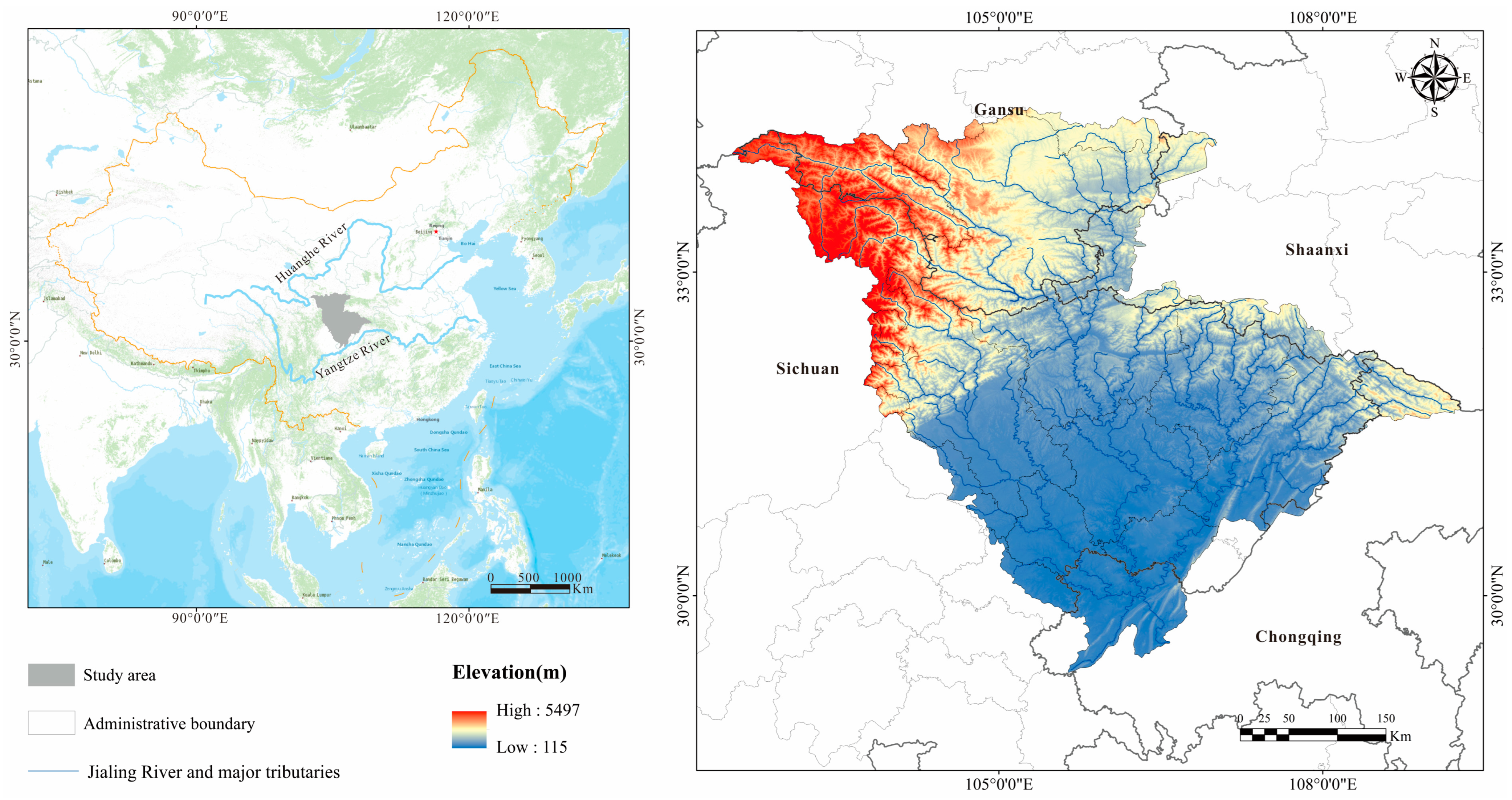
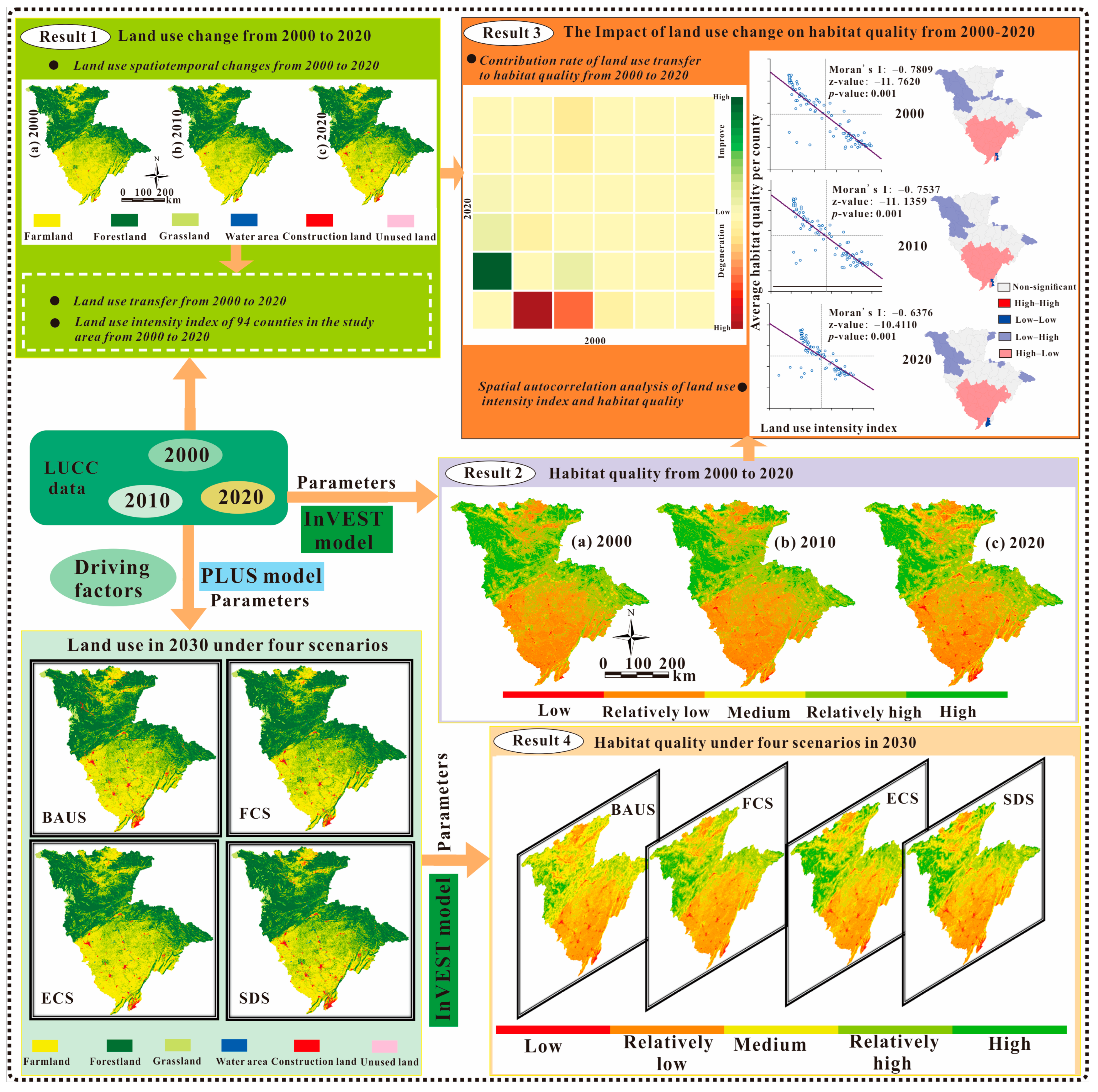
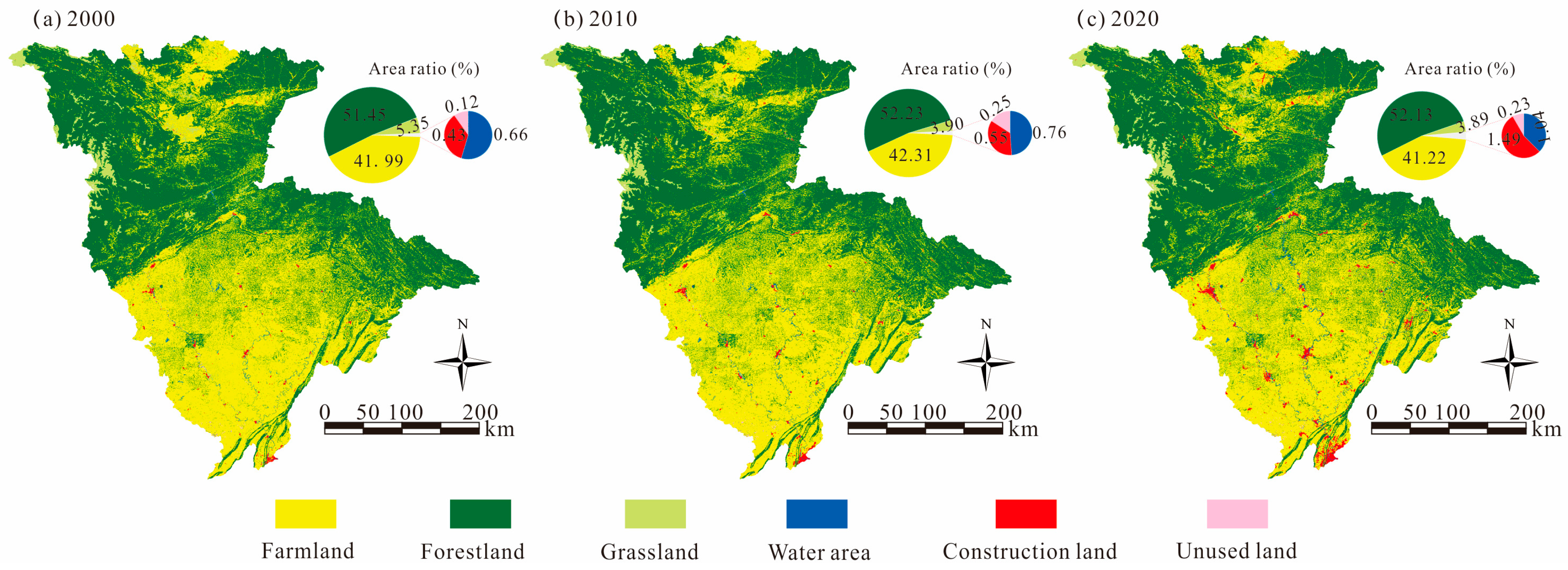
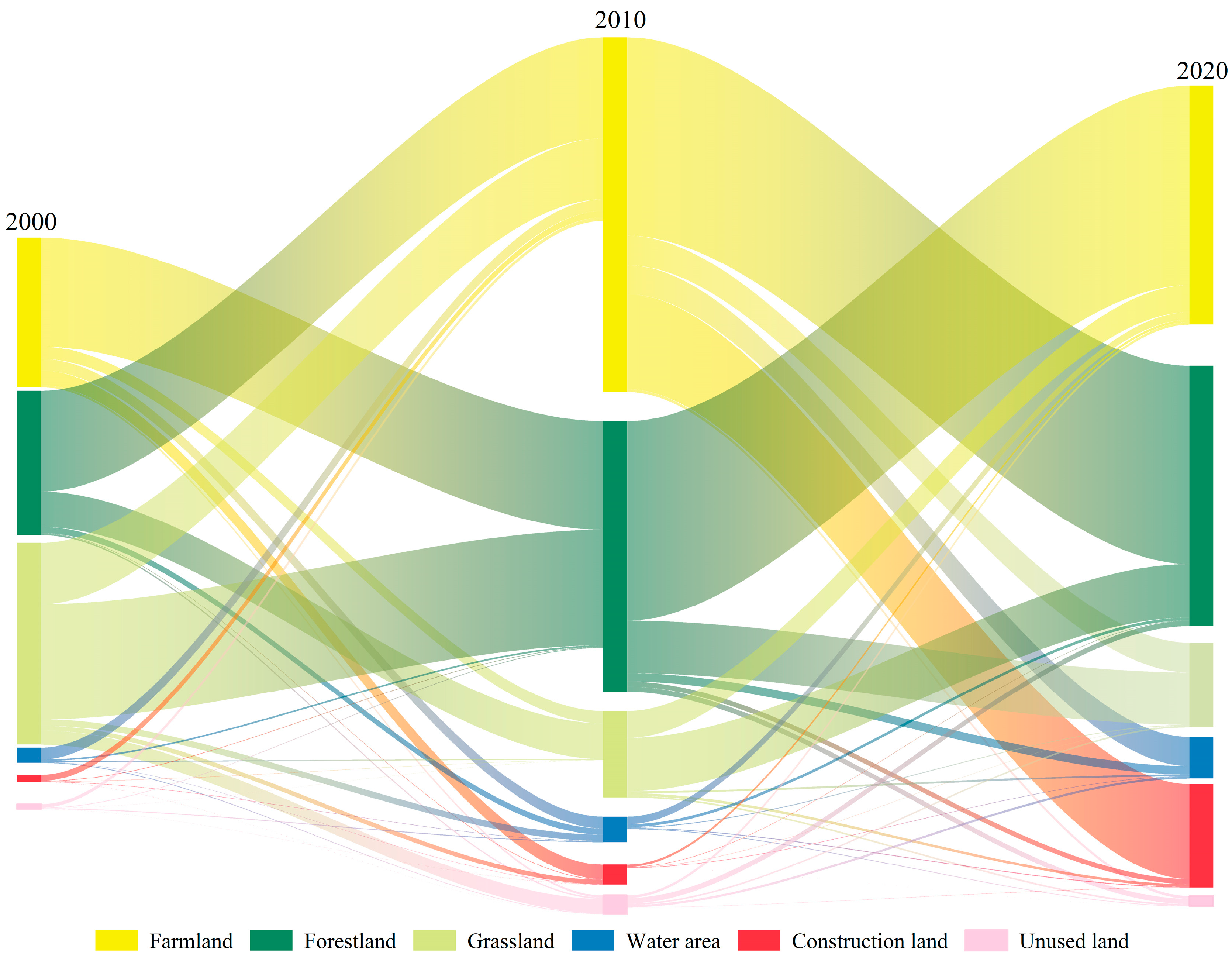

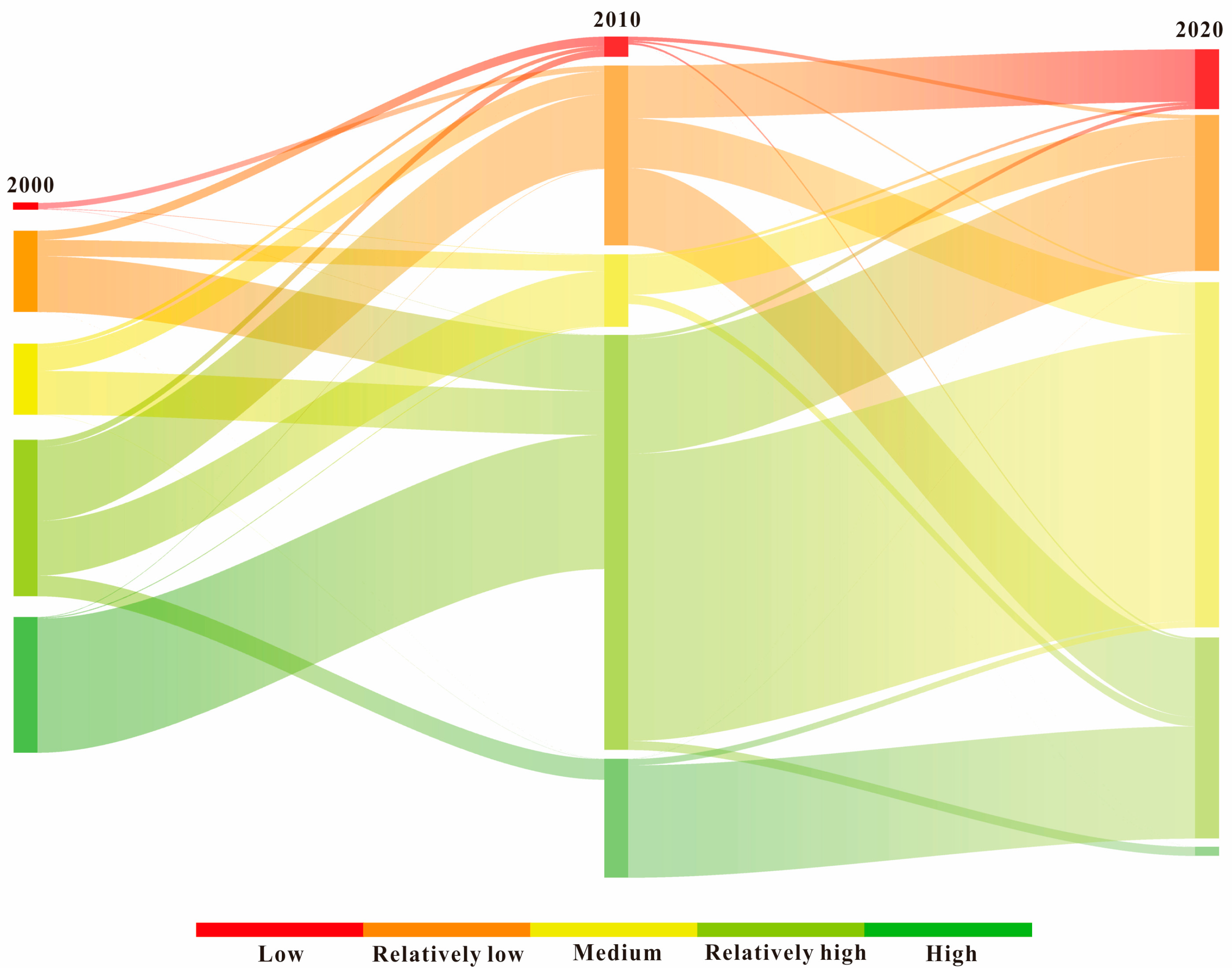

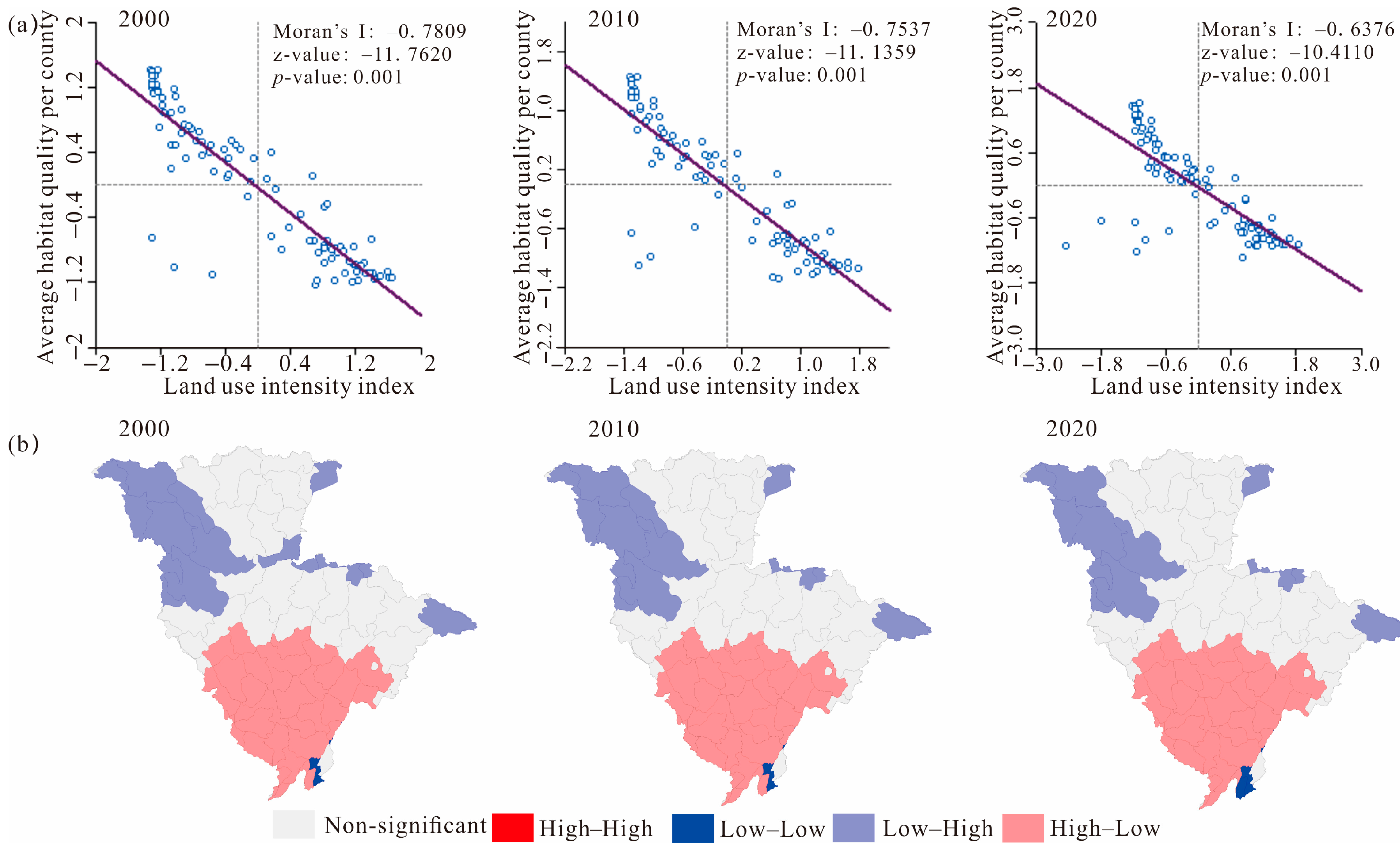
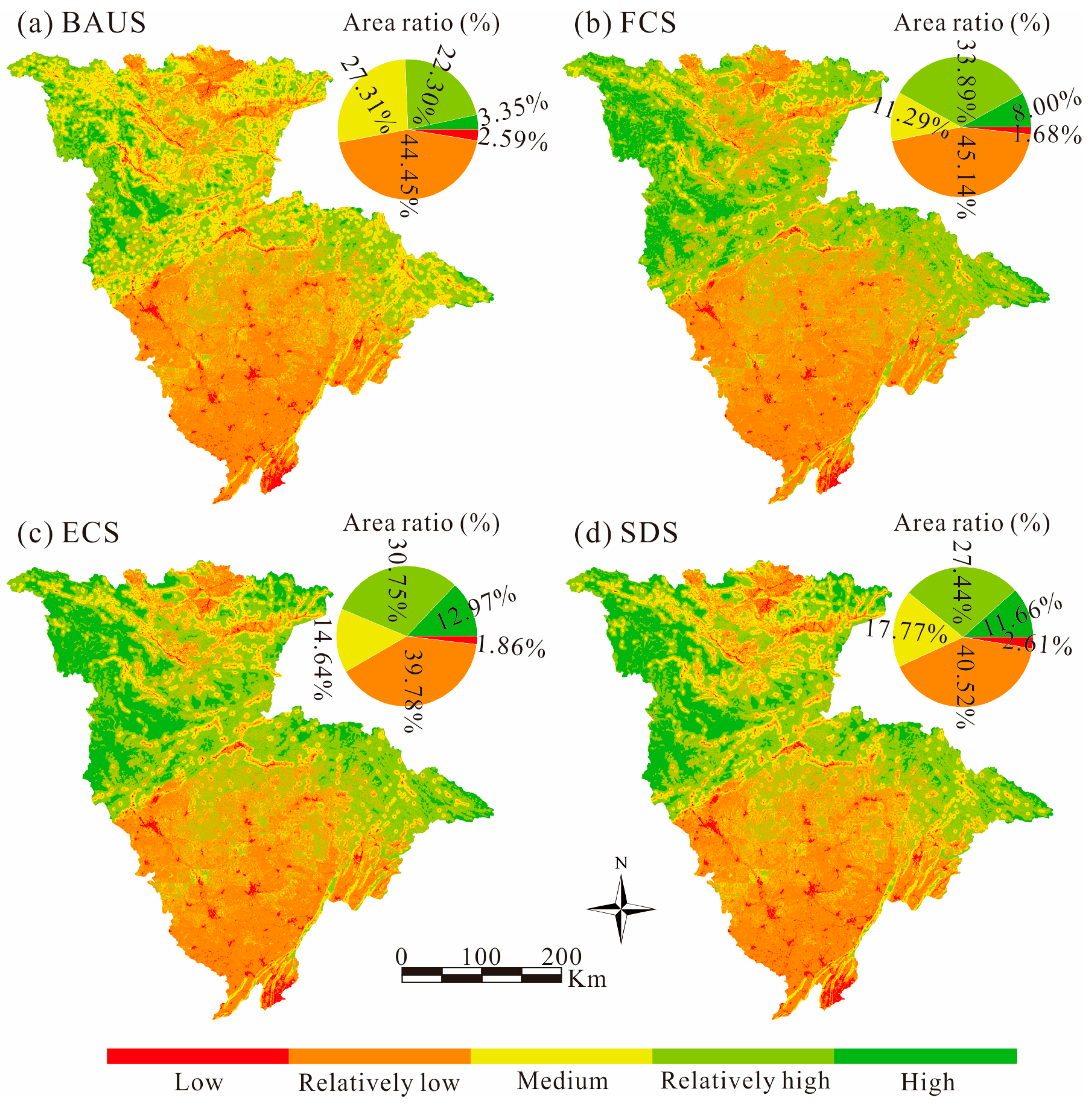
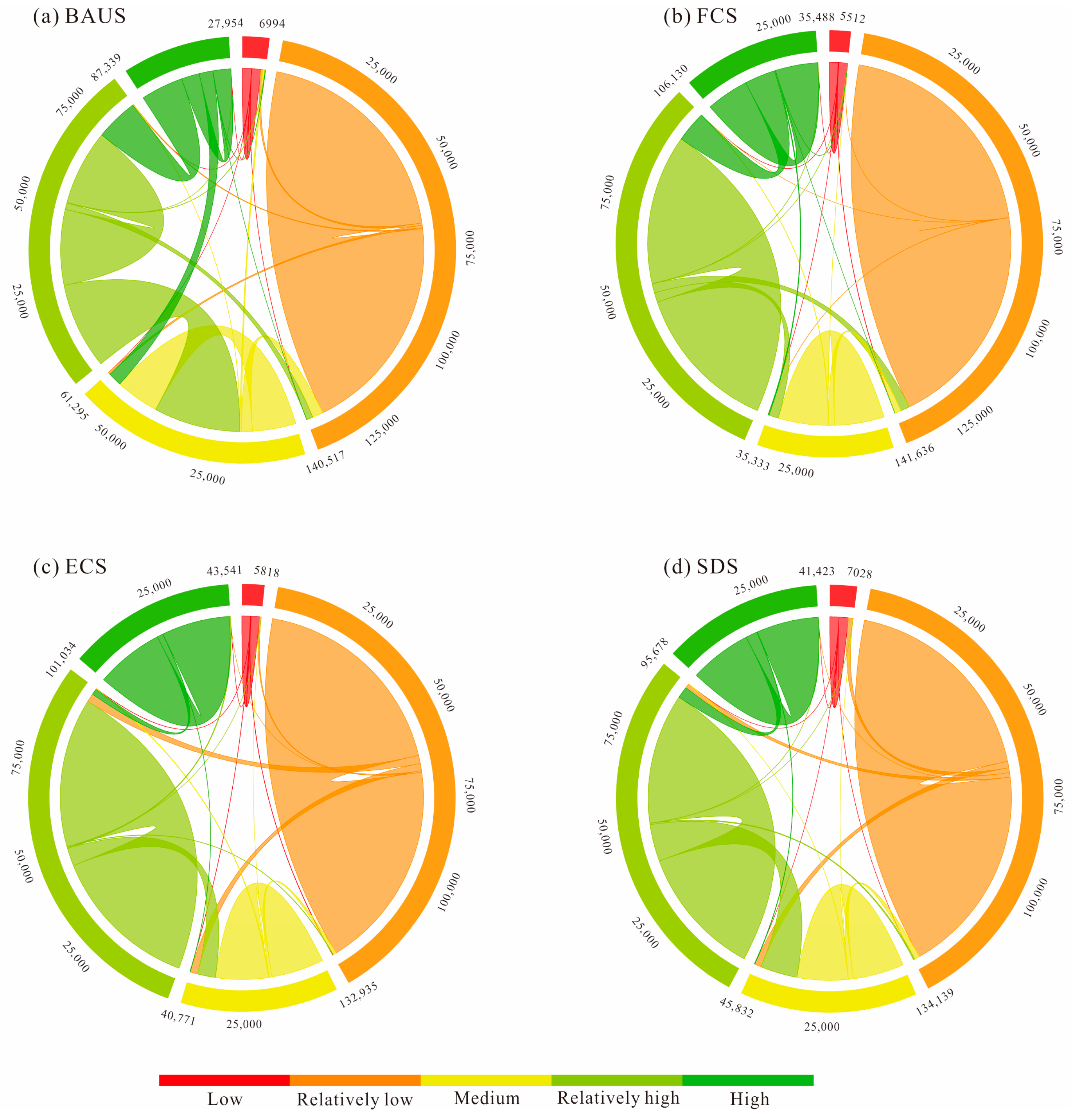
| Scenarios | Land Use Demand (km2) | ||||||
|---|---|---|---|---|---|---|---|
| Farmland | Forestland | Grassland | Water Area | Construction Land | Unused Land | Total | |
| BAUS | 65,258 | 84,263 | 6273 | 2059 | 3833 | 363 | 162,049 |
| FCS | 71,296 | 80,692 | 5753 | 1595 | 2398 | 315 | 162,049 |
| ECS | 61,293 | 90,365 | 5107 | 2059 | 3020 | 206 | 162,049 |
| SDS | 61,451 | 87,604 | 6708 | 2058 | 3865 | 365 | 162,049 |
| BAUS | FCS | ECS | SDS | |||||||||||||||||||||
|---|---|---|---|---|---|---|---|---|---|---|---|---|---|---|---|---|---|---|---|---|---|---|---|---|
| A | B | C | D | E | F | A | B | C | D | E | F | A | B | C | D | E | F | A | B | C | D | E | F | |
| A | 1 | 1 | 1 | 1 | 1 | 1 | 1 | 0 | 0 | 0 | 0 | 0 | 1 | 1 | 1 | 1 | 1 | 1 | 1 | 1 | 1 | 1 | 1 | 1 |
| B | 1 | 1 | 1 | 1 | 1 | 1 | 1 | 1 | 1 | 0 | 1 | 1 | 0 | 1 | 1 | 1 | 1 | 0 | 1 | 1 | 1 | 1 | 1 | 1 |
| C | 1 | 1 | 1 | 1 | 1 | 1 | 1 | 1 | 1 | 1 | 1 | 1 | 0 | 1 | 1 | 1 | 1 | 0 | 1 | 1 | 1 | 1 | 1 | 1 |
| D | 1 | 1 | 1 | 1 | 1 | 1 | 1 | 0 | 1 | 1 | 0 | 0 | 0 | 0 | 0 | 1 | 0 | 0 | 0 | 0 | 0 | 1 | 1 | 0 |
| E | 1 | 1 | 1 | 1 | 1 | 1 | 1 | 1 | 1 | 1 | 1 | 1 | 1 | 1 | 1 | 1 | 1 | 1 | 1 | 0 | 1 | 0 | 1 | 0 |
| F | 1 | 1 | 1 | 1 | 1 | 1 | 1 | 1 | 1 | 1 | 1 | 1 | 1 | 1 | 1 | 1 | 1 | 1 | 1 | 1 | 1 | 1 | 1 | 1 |
| Threat Sources | Decay | Distance of Maximum Impact (km) | Weight |
|---|---|---|---|
| Unused land | Linear | 4 | 0.4 |
| Construction land | Exponential | 9 | 0.9 |
| Farmland | Linear | 5 | 0.5 |
| Land Use Type | Farmland | Forestland | Grassland | Water Area | Construction Land | Unused Land |
| Habitat suitability | 0.3 | 0.9 | 0.7 | 0.75 | 0 | 0 |
| Unused land | 0.1 | 0.2 | 0.2 | 0.2 | 0 | 0 |
| Construction land | 0.6 | 0.6 | 0.5 | 0.8 | 0 | 0.2 |
| Farmland | 0 | 0.8 | 0.4 | 0.7 | 0 | 0 |
| Year | Land Use Area (km2) and Proportion (%) | |||||
|---|---|---|---|---|---|---|
| Farmland | Forestland | Grassland | Water Area | Construction Land | Unused Land | |
| 2000 | 68,042 (41.99) | 83,374 (51.45) | 8663 (5.35) | 1076 (0.66) | 701 (0.43) | 194 (0.12) |
| 2010 | 68,558 (42.31) | 84,640 (52.23) | 6328 (3.90) | 1233 (0.76) | 891 (0.55) | 399 (0.25) |
| 2020 | 66,791 (41.22) | 84,478 (52.13) | 6300 (3.89) | 1682 (1.04) | 2424 (1.49) | 374 (0.23) |
| Year | 2010 | |||||||
| A | B | C | D | E | F | Total | ||
| 2000 | A | 65,749 | 1669 | 190 | 179 | 222 | 32 | 68,042 |
| B | 1544 | 81,164 | 543 | 95 | 8 | 22 | 83,374 | |
| C | 935 | 1765 | 5575 | 97 | 71 | 219 | 8663 | |
| D | 179 | 25 | 14 | 844 | 3 | 10 | 1076 | |
| E | 97 | 8 | 4 | 6 | 585 | 1 | 701 | |
| F | 53 | 9 | 2 | 13 | 1 | 115 | 194 | |
| Total | 68,558 | 84,640 | 6328 | 1233 | 891 | 399 | 162,049 | |
| Year | 2020 | |||||||
| A | B | C | D | E | F | Total | ||
| 2010 | A | 63,131 | 3033 | 456 | 443 | 1452 | 43 | 68,558 |
| B | 3057 | 80,492 | 801 | 129 | 79 | 81 | 84,640 | |
| C | 411 | 819 | 5004 | 29 | 39 | 25 | 6328 | |
| D | 116 | 43 | 12 | 1041 | 11 | 10 | 1233 | |
| E | 36 | 6 | 3 | 7 | 839 | 0 | 891 | |
| F | 40 | 84 | 24 | 33 | 4 | 215 | 399 | |
| Total | 66,791 | 84,478 | 6300 | 1682 | 2424 | 374 | 162,049 | |
| Year | Area (km2) | ||||
|---|---|---|---|---|---|
| Low | Relatively Low | Medium | Relatively High | High | |
| 2000 | 894 | 68,531 | 8414 | 55,158 | 29,053 |
| 2010 | 1291 | 69,166 | 8454 | 57,424 | 25,715 |
| 2022 | 2798 | 68,481 | 17,043 | 51,205 | 22,523 |
| Year | 2010 | ||||||
| A | B | C | D | E | Total | ||
| 2000 | A | 703 | 166 | 17 | 9 | 0 | 894 |
| B | 268 | 66,164 | 473 | 1625 | 1 | 68,531 | |
| C | 119 | 672 | 6345 | 1272 | 6 | 8414 | |
| D | 200 | 2147 | 1589 | 50,620 | 602 | 55,158 | |
| E | 1 | 18 | 29 | 3899 | 25,106 | 29,053 | |
| Year | 2020 | ||||||
| A | B | C | D | E | Total | ||
| 2010 | A | 1058 | 116 | 55 | 60 | 1 | 1291 |
| B | 1528 | 63,940 | 1446 | 2249 | 2 | 69,166 | |
| C | 90 | 1086 | 7008 | 269 | 0 | 8454 | |
| D | 120 | 3333 | 8348 | 45,360 | 263 | 57,424 | |
| E | 2 | 5 | 186 | 3266 | 22,258 | 25,715 | |
Disclaimer/Publisher’s Note: The statements, opinions and data contained in all publications are solely those of the individual author(s) and contributor(s) and not of MDPI and/or the editor(s). MDPI and/or the editor(s) disclaim responsibility for any injury to people or property resulting from any ideas, methods, instructions or products referred to in the content. |
© 2024 by the authors. Licensee MDPI, Basel, Switzerland. This article is an open access article distributed under the terms and conditions of the Creative Commons Attribution (CC BY) license (https://creativecommons.org/licenses/by/4.0/).
Share and Cite
Duan, X.; Chen, B.; Zhang, T.; Guan, Y.; Zeng, K. Habitat Quality Evolution and Multi-Scenario Simulation Based on Land Use Change in the Jialing River Basin. Sustainability 2024, 16, 6968. https://doi.org/10.3390/su16166968
Duan X, Chen B, Zhang T, Guan Y, Zeng K. Habitat Quality Evolution and Multi-Scenario Simulation Based on Land Use Change in the Jialing River Basin. Sustainability. 2024; 16(16):6968. https://doi.org/10.3390/su16166968
Chicago/Turabian StyleDuan, Xiong, Bin Chen, Tianxiang Zhang, Yuqi Guan, and Kun Zeng. 2024. "Habitat Quality Evolution and Multi-Scenario Simulation Based on Land Use Change in the Jialing River Basin" Sustainability 16, no. 16: 6968. https://doi.org/10.3390/su16166968
APA StyleDuan, X., Chen, B., Zhang, T., Guan, Y., & Zeng, K. (2024). Habitat Quality Evolution and Multi-Scenario Simulation Based on Land Use Change in the Jialing River Basin. Sustainability, 16(16), 6968. https://doi.org/10.3390/su16166968







